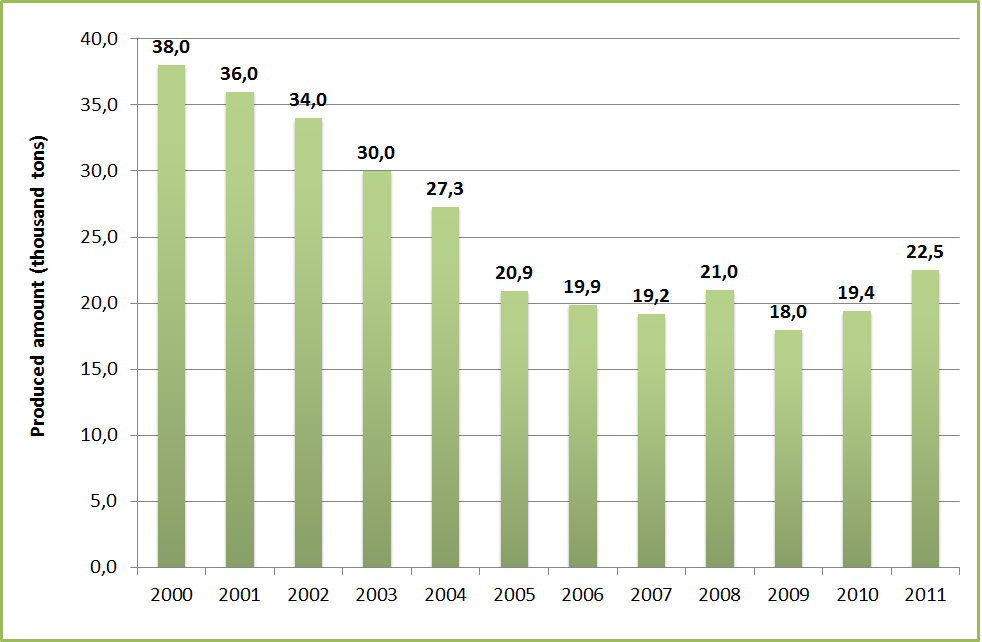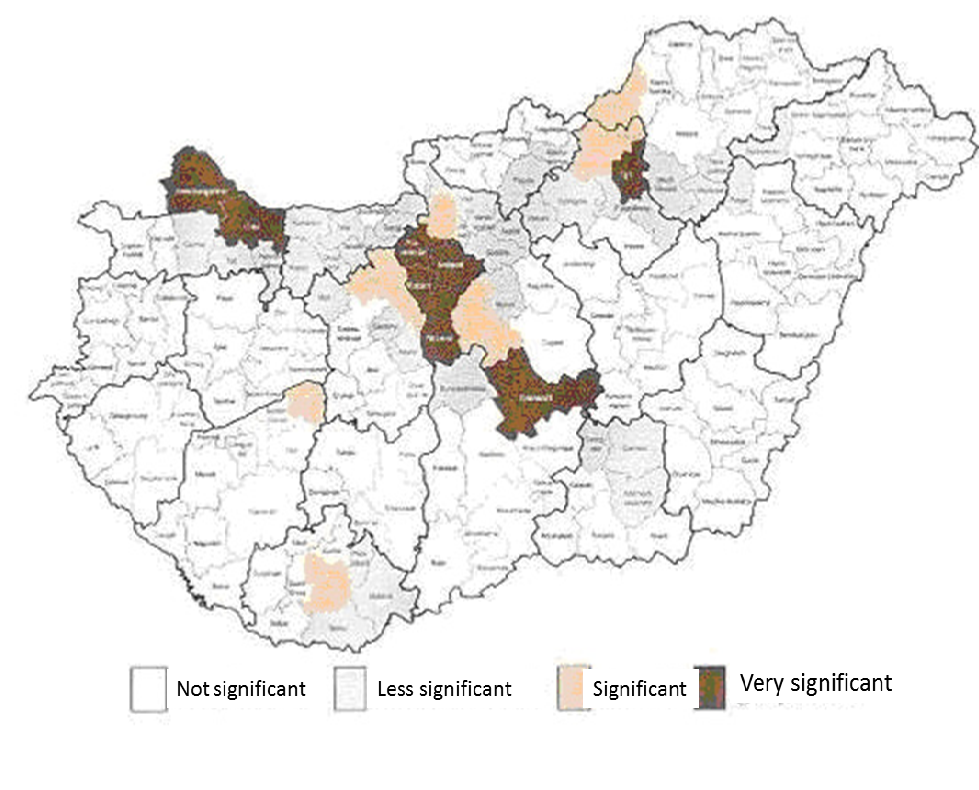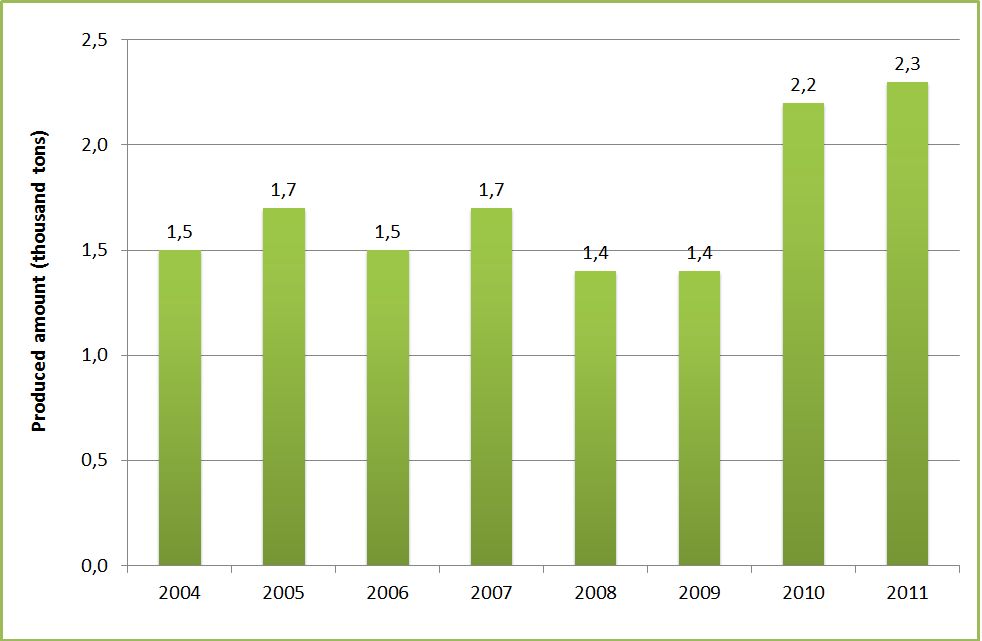Cultivated mushroom species of the world, Europe and Hungary
Author: Anna Szabó
A large amount of organic byproduct and waste with high lignocellulose content is produced in agriculture, forestry and in the food industry. Only 30% of these materials are recycled. Since they are exceptional nutrient sources for mushrooms, one of the possible and effective ways of recycling these wastes and byproducts (agricultural and industrial discards) is to use them in mushroom cultivation. For example the following materials are suitable for this purpose: grain straw, horse and poultry manure, maize stem and cob, paddy, pea and soy straw, sawdust, chip, tealeaf, coffee bean husk etc.
Besides the nutritional values, many mushroom species have medicinal properties as well. A number of mushroom species are cultivated or collected in Asia, which have been used as traditional remedies for hundreds of years. In the past two decades people of developed countries have started to show interest in the different uses of medicinal plants and mushrooms. Mycotherapy is a fairly new expression for using mushrooms or mushroom products (medicinal mushrooms) as remedies. Some cultivated mushrooms (e.g. selenium enriched button mushrooms) are now even considered as functional foods. (The European Commission Concerted Action on Functional Food Science in Europe defined functional foods as follows: “a food product can only be considered functional if together with the basic nutritional impact it has beneficial effects on one or more functions of the human organism thus either improving the general and physical conditions or/and decreasing the risk of the evolution of diseases.")
The main qualities of mushrooms:
- Mushrooms can serve as protein sources in poverty and hunger stricken countries, where the amount of available animal-based proteins is not sufficient;
- Mushrooms are getting a more and more important role in healthy and vegetarian diets;
- New mushroom-based supplements and medicinal products can be used for medical purposes;
- By recycling agricultural, forestry and food industrial byproducts and wastes, mushroom cultivation have a significant role in environment protection.
Mushrooms cultivation started a long time ago, firstly in China. The following table shows the date of first cultivation attempts in case of the different mushroom species. Since the beginning, the initial cultivation technologies have developed to those we use nowadays.
The first cultivation attempts of mushroom species (Chang-Miles, 2004)
|
Év* |
Faj neve |
Év* |
Faj neve |
|
600 |
1982 |
Dictyophora duplicata |
|
|
800 |
1982 |
Hohenbuehelia serotina |
|
|
1000 |
Lentinula edodes (shiitake) |
1982 |
Oudemansiella radicata |
|
1600 |
1983 |
Armillaria mellea |
|
|
1621 |
1983 |
||
|
1700 |
1983 |
Pleurotus sapidus |
|
|
1800 |
1984 |
Amanita ceasarea |
|
|
1900 |
1984 |
||
|
1950 |
1984 |
Hericium coralloides |
|
|
1958 |
1985 |
Sparassis crispa |
|
|
1958 |
Pleurotus florida |
1985 |
Tremella mesenterica |
|
1958 |
1986 |
||
|
1960 |
1987 |
Lyophyllum ulmarium |
|
|
1961 |
Agaricus bitorquis |
1988 |
Lentinus tigrinus |
|
1962 |
Pleurotus flabellatus |
1989 |
Gloestereum incarnatum |
|
1969 |
Pleurotus cystidiosus |
1990 |
Tricholoma lobayense |
|
1973 |
Hypsizygus marmoreus |
1991 |
Tricholoma gambosum |
|
1974 |
Pleurotus sajor-caju |
1991 |
Tricholoma mongolicum |
|
1981 |
Pleurotus citrinopileatus |
1997 |
As shown on Table many species unknown to European people were and are cultivated in the Far East.
The next table summarizes the current scientific binomial name and English version of most important cultivated mushroom species.
Latin-English mushroom vocabulary
|
Scientific name |
Common name |
|
Agaricus bisporus |
button, champignon de Paris, commercial, common, white button |
|
Agaricus bisporus |
cremini, portabella, portobella, |
|
Agaricus bitorquis |
spring agaricus, warm-weather button |
|
Agrocybe aegerita |
poplar, brown swordbelt |
|
Armillaria matsutake |
matsutake |
|
Auricularia auricula |
black ear, cloud ear, kikurage, mou er, |
|
Coprinus comatus |
lawyer’s wig, shaggy-mane |
|
Flammulina velutipes |
Christmas, golden, snow puff, velvet stem, winter, enokitake (enoki), |
|
Ganoderma lucidum |
ling chi, mannentake, reishi |
|
Grifolia frondosa |
hen of the woods, maitake |
|
Hericium erinaceus |
bear’ head, choux-fleur, pompom, lion’ mane |
|
Lentinula edodes |
black, black forest, golden oak, oak tree, shiitake, tung ku |
|
Lepista nuda |
blewit, wood blewit |
|
Morchella esculenta |
true morel, sponge |
|
Pholiota nameko |
nameko |
|
Pleurotus abalonus |
abalone |
|
Pleurotus citrinopileatus |
tamogitake |
|
Pleurotus columbinus |
blue oyster |
|
Pleurotus cornucopiae |
golden oyster, horn of plenty, tamogitake |
|
Pleurotus djamor |
pink oyster |
|
Pleurotus eringii |
king oyster |
|
Pleurotus ostreatus |
oyster, pearl oyster, tree oyster, willow, hiratake, shimeji, |
|
Pleurotus “sajor-caju” |
Indian oyster, phoenix |
|
Stropharia rugoso-annulata |
giant stropharia, king stropharia, wine cap |
|
Tremella fuciformis |
snow fungus, silver ear, shirokikurage |
|
Volvariella volvacea |
paddy straw, straw, fukurotake |
The World mushroom production
Nowadays 30 mushroom species are cultivated in a large amount around the World. The following 10 of the 30 species give 95% of total production:
- 37,6% button mushroom (Agaricus bisporus, A. bitorquis),
- 16,8% shiitake (Lentinula edodes),
- 16,3% oyster species (Pleurotus spp.),
- 8,5% jelly ear mushrooms (Auricularia spp.),
- 6,1% paddy straw mushroom (Volvariella volvacea),
- 4,7% enoki (Flammulina velutipes),
- ~10% snow fungus (Tremella fuciformis), buna shimeji (Hypsizygus marmoreus), monkey head mushroom (Hericium erinaceus) and nameko (Pholiota nameko) together.
The most important cultivated species are: button mushrooms, shiitake, the different oyster species and the jelly ear and paddy straw mushrooms, which were together 90% of world production in 2004 and 87% in 2007. The leading position of button mushrooms has not changed since decades, although the total production gets lower percent by percent each year. Button mushrooms are cultivated on each continent, in more than 100 countries. In 2011 China was first, USA was second in button mushroom cultivation. 90% of shiitake – the species cultivated in the second highest amount – is produced in China. Some sources put oyster in second place (and consider jelly ear mushroom production to be more significant than that of button mushroom).
Mushroom sales (including cultivated as well as collected mushrooms and medicinal mushroom products) totaled $40B USD in 2001. Since the demand for mushrooms grows, many countries (China, India, Vietnam and South Korea) are increasing production.
65% of the total production is sold on the markets of 6 counties: USA, France, Canada, Germany, Great Britain and Italy, at the same time the Chinese market is growing as well. Consumers are especially interested in functional foods, which is advantageous for medicinal mushroom production. Medicinal mushroom cultivation is spreading, but not yet common in the above mentioned countries. That is why they mostly export from the Far East, where these species are traditionally grown.
Button mushroom cultivation in Europe
Button mushroom production of most EU countries has increased in the past 15 years. White button mushroom is still preferred, but the cream type is getting more and more popular. The highest amount of button mushroom was grown in 2000 (842 050 tons), but each year this amount gets lower. By 2004, 50 000 tons less button mushroom was produced. The production rates dropped even in the Netherlands, but the most significant change happened in France, where in 2005 65 000 tons less button mushrooms were grown than in 2000. Most of the French mushrooms (75%) are sold canned, but the demand for canned products (e.g. in Germany) decreases, thus causing marketing difficulties. Another reason for the market loss could be that the traditional picking method is not suitable for quality production. In France, Italy and in Spain the base of the stem with casing soil residues on it is not removed during picking, thus the mushrooms are “dirty”.
The production decreased in Great Britain and in Ireland as well. Nowadays they import more than they grow. Import mushrooms come from Poland instead of Holland. In the past three decades the Netherlands used to be the lead producer in Europe until 2011, when Poland took its place. Germany produced lower amounts too, but their import increased dynamically. Consumers mainly buy mushrooms from September until the asparagus season and then until summer, when wild grown mushrooms are preferred. Mushrooms are only imported to Austria from Hungary and Poland.
In the past 15 years a drastic improvement of mushroom production took place in Poland and they became number one producers of Europe. The mushroom production was 100 000 tons on 120 000 ha in 2000, 180 000 tons on 205 000 ha in 2004, 200 000 tons in 2005 and 230 000 tons in 2009. The reasons for this change are the lower production costs. Poland exports both fresh and processed mushrooms (mainly to Germany). In 2008 28 400 t, in 2009 24 700 t of fresh and 8 100 and 5 500 tons of canned mushrooms were sold abroad. Another destination of the Polish products are Holland (16 600 in 2008 and 15 300 in 2009), where the mushrooms mostly get resold.
Button mushroom and oyster production in Hungary
In 2011 of the total 25 000 tons of Hungarian production 92-93% was button mushrooms (22 500 t), 6-7% oyster (2 300 t) and 1% (200 t) other species. 15-20 big and 300 smaller companies were in the mushroom business.
Apart from the above mentioned species, shaggy mane (Coprinus comatus), king oyster (Pleurotus eryngii), reishi ( Ganoderma lucidum), monkey head mushroom (Hericium erinaceus) and enoki (Flammulina velutipes) are grown in larger scale. Although they can be found in bigger supermarkets (mainly imported from China and sold at a high price) Hungarian consumers do not really know these species.
90% of the total button mushroom production is white strains, while the cream type is only 8-10%. The latter is mostly exported and sold on West European markets. The caps of cream type button mushrooms strains are light to dark brown, the stem is usually white. The two categories of cream type mushrooms are Portobello and Crimini (Baby Portobello). Portobello is a biologically mature fruiting body, the 10-12 cm sized cap is opened and both the cap and the stem are thick. Crimini is not fully mature, smaller than Portobello – that is why it is called Baby Portobello.
The changes of Hungarian mushroom production in the past ten years are shown on the following graph). The amount of grown mushroom decreased with each year since 2000, when production was the highest (38 000 tons). A few years ago a modern Dutch-type growing house was built in Ócsa (Bio-Fungi Kft.), where mushrooms are grown in a large quantity and high quality. Partly that is the reason why Hungarian production started to increase again in 2010.

Hungarian button mushroom production in 2000-2011 (FruitVeb)
In Hungary Button mushrooms are grown traditionally in the Budapest area and in the Northwest region of the country. Almost half of the total amount is grown around Budapest in traditional limestone cellars and in modern Dutch houses. The most important mushroom growing areas of Hungary are shown here

Hungarian mushroom growing areas (FruitVeb, 2010)
The changes derive from the facts that the profitability gets lower with each year, the Euro-HUF exchange rates fluctuate and the demand from the consumers is lower. Ever since the financial crisis consumers – although know the health beneficial effects of mushrooms – do not buy as much mushroom products as before.
Hungarian compost plants in one hand supply Hungarian growers, in the other hand export high amounts into surrounding countries. In 2011 ~120 000 tons of compost was produced (from which 40 000 tons was exported mainly to Romania, Croatia, Serbia and to Slovakia). 50% of the total compost and substrate amount is sold to Romania. Some companies cannot keep up with the demands of the constantly developing technology, for example a large compost plant in Tök has closed recently.
90% of fresh Hungarian oyster mushroom is exported. In 2011 3 800-4 500 tons from the total 15 000 tons of substrate was exported as well. The destination of both the fresh product and the substrate is Romania, Croatia, Serbia and Slovakia.

Hungarian oyster production in 2004-2011 (FruitVeb)
The substrate plant of Pilze-Nagy Kft. has launched in 2003, in Kecskemét. Pilze-Nagy Kft. is considered to be one of the biggest oyster grower and trader and substrate producer companies in Europe. It gives 90% of the total Hungarian substrate production (the remaining 10% is made by small growers, who prepare the substrate they need) and 85-90% of Hungarian oyster production. The most significant oyster growing area is around Kecskemét.
Test your knowledge!
- Which are the most important mushroom species grown in Hungary (with Latin name)?
- What were the most important changes in Hungarian mushroom production in the past decade?
- What is the ratio of the different mushroom species grown in Hungary?
- Describe the European button mushroom production!
- What are the reasons of the Polish mushroom business development?
References
Chang, S.T. (1996): Mushroom research and development - Equality and mutual benefit. In: Mushroom Biology and Mushroom Products. Royse, D.J. editor. University Park: Pan, 1-10.
Chang, S.T. (2000): The world mushroom industry: Trends and technological development. International Journal of Medicinal Mushrooms, 8: 297-314.
Bullmann, D. (1998): A Malthusian Predection for North American Mushroom Producers - Trends in Global Production & Consumption. Mushroom News, 10: 12-21.
Delcaire, J. R. (1978): Economics of cultivated mushrooms. In: The Biology and Cultivation of Edible Mushrooms. Chang, S. T. & Hayes, H.A., editors. New York: Academic, 726-793.
FruitVeb Bulletin (2012): Magyar Zöldség Gyümölcs Szakmaközi Szervezet kiadványa, Budapest.
Grabbe, K. (1997): A gombák helye az emberi táplálkozásban. Magyar Gombahíradó, 16: 6-7.
Győrfi, J. (2005): Csiperketermesztés Európában. Kertgazdaság, 37,4: 5-9.
Győrfi, J. (2007): Csiperketermesztés Európában és Magyarországon. Agrofórum, 18,10: 72-74.
Győrfi, J., Geösel, A. (2008): Gondolatok a gombatermesztésről.Agrofórum, 19, 1: 36-38.
Győrfi, J. (2003): Csiperketermesztés nemcsak vállalkozóknak.Szaktudás Kiadó Ház, Budapest,, 5-199.
Győrfi, J. (2010): Gombafajok termesztése a világon, Európában és Magyarországon. (In: Győrfi, J. (szerk): Gombabiológia, gombatermesztés. Mezőgazda Kiadó, Budapest, 114-121.

